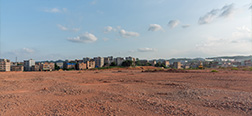Environmental Risk Diagnosis in China
As environmental regulations are being developed worldwide, stricter regulations are particularly noticeable in China. Dealing with regional regulations and production restrictions that are often imposed when international conferences are held is a heavy burden for companies entering the Chinese market. However, the policies not only tighten regulations, there are also deregulation systems for environmentally friendly companies, and there are cases where progressive measures are desirable.

Responding to the risk of a factory shutdown
Environmental risk diagnosis aims to evaluate the environmental conditions of factories currently in operation, identify problems and make suggestions for improvement in accordance with the latest legal and regulatory trends in each region of China. We evaluate the risks of a shutdown due to environmental regulations as they relate to our own factories and suppliers and contribute to the reduction of shutdown risks, such as production restrictions, energy savings and improvements in the recycling rate.
It is also possible to evaluate Occupational Health and Safety (OHS) aspects in parallel with this environmental evaluation. During this procedure, it is possible to perform an environmental risk diagnosis online, without conducting a field survey. We use web-based techniques is to prioritise work to be done in a large number of factories for selection by region and industry, and for factories operating under strict environmental regulations.

Cases where environmental risk diagnosis is required
We have diagnosed environmental risks and proposed solutions for customers facing the following circumstances:
- Suppliers of parts from our business partner factories suddenly stopped delivery due to environmental regulations. We want to improve our suppliers' environmental measures and maintain our supply chain.
- Factory production cut regulations have not been lifted. We need you to diagnose what has caused this.
- Since the start of operations, a small amount of VOC-containing adhesives have been used in our bonding process. We need you to determine whether or not these levels are legal under the current environmental regulations.
- We need to know how much electricity, gas and water are used, and the amount of waste and CO2, are being emitted, so we can save energy and improve our recycling rate.
- We are planning to relocate. We need to know about environmental risks, schedules and countermeasure costs.
- We want to ease production cuts during times of heavy pollution. We would like to be reclassified from a Class D company to Class A.
- We would like to maintain and increase our production capacity by taking appropriate environmental measures while adhering to stricter environmental regulations.
- We need instruction on how far to take environmental measures.
Features of environmental risk diagnoses provided by EnBio
The environmental risk diagnoses provided by EnBio evaluate each factory's environmental documents, records, monitoring results, local conditions and its suitability for administrative guidance, laws and long-term policies. Our diagnoses include the following five elements:
- An understanding of the administrative guidance published by local environmental departments
- Diagnosis based on an evaluation of environmental monitoring results and numerical values
- Solutions (method, construction period, budget, equipment) for each field related to the factory’s environmental issues
- Fields to be surveyed are: 1) local environmental laws and regulations, 2) compliance with environment-related texts and production processes, 3) exhaust, 4) wastewater, 5) soil and groundwater, 6) hazardous waste, 7) slope disaster prevention, land subsidence and flooding
- When working to solve environmental issues, we provide consulting, investigation, restoration, equipment provision and administrative responses.
If a problem is found as a result of our diagnosis, EnBio will offer a solution for each field. In addition, even if there are no issues, we can provide services, such as information provision and consultation.
Diagnostic results can be used as part of environmental due diligence during M&A procedures.
| Challenge | Field | Solutions (method, construction period, budget, equipment) for each field |
|---|---|---|
| Yes | Environmental documents | Consulting on how to prepare an environmental impact assessment report and how to create a ledger |
| Factory exhausts (VOCs and foul odours) | Evaluate the removal efficiency of VOCs and the cause of malodour, make proposals for non-organised waste containment and the provision of high-efficiency exhaust treatment equipment | |
| Soil and groundwater | Support for responses as a priority monitoring company, process arrangement for land use rights transfers, proposals for voluntary investigations and restoration, administrative response support | |
| Wastewater / waste | Use of special filter technology to collect valuable metals and reduce wastewater and sludge | |
| Electricity / water / gas / CO2 | Proposals for energy saving and recycling using measuring equipment, special filter technology and environmental equipment | |
| No |
Providing environmental regulations information related to production suspension risks Environmental consulting |
Minor nonconformities (when there is risk of production suspension)
It is difficult to clear all the complicated laws and regulations in China, and there are many cases where a minor nonconformity or greater nonconformity is confirmed as a result of an environmental risk diagnosis. In addition, the breakdown of the criteria confirmed as a ‘minor nonconformity’ are most often related to air pollution controls (exhausts of oil smoke, VOCs, etc.). In recent years, China’s air-related laws and regulations have been rapidly tightened, and it is not uncommon for temporary production restrictions to be imposed because of exhaust levels.
EnBio understands the details of factories’ exhaust status and can propose specific solutions, introduce equipment as needed and provide as support for complying with exhaust regulations.
- Procedures for environmental impact assessment reports are not implemented when relocating, expanding or remodelling equipment [risk of production suspension]
- Continued production with an unaccepted completion environment inspection certificate [risk of production suspension]
- VOCs, non-methane hydrocarbons and concentration standards are met, but it is suspected that the total emission index value is still exceeded.
- Leakage of waste oils and liquids into rainwater drains
- Total emissions are not managed
- Unapproved industrial wastewater [risk of production suspension]











